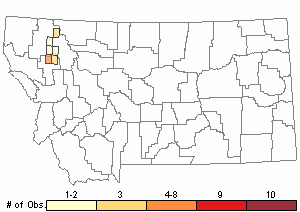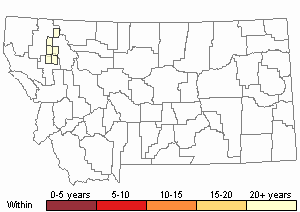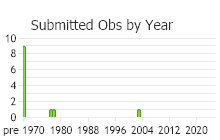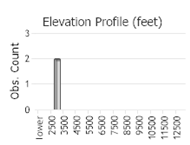View in other NatureServe Network Field Guides
NatureServe
Montana
Utah
Wyoming
Idaho
Wisconsin
British Columbia
South Carolina
Yukon
California
New York
A Wing Moss - Herzogiella seligeri
General Description
Plants: Pleurocarpous, growing in slender, interwoven mats, pale green, sometimes with yellow tones (FNA 2014), shiny (Lawton 1971). Stems prostrate to upwardly inclined, sometimes reaching 3 cm in length and to 3 mm in width (FNA 2014), branching erratically (Smith 1980); central strand obscure if present; hyalodermis sometimes obscure; rhizoids few, papillose; pseudoparaphyllia lacking (FNA 2014).
Leaves: Arranged in several rows along the stem, spreading quite widely (FNA 2014) and frequently curving toward one side near the stem and branch ends (Lawton 1971), 1-2.5 mm in length, to 0.9 mm in width, cupped, neither pleated nor wavy, egg- to lance-shaped, the acumen sometimes long; base not extending down the stem or only slightly so (by up to 3 cells); leaf edges flat, saw-toothed, sometimes finely so (FNA 2014), occasionally smooth below (Lawton 1971); costa mostly short and paired, seldom absent; branch and stem leaves akin (FNA 2014).
Leaf Cells: Laminal cells somewhat long and thin, tapering at both ends, smooth; basal laminal cells usually porose, obscurely so above; alar cells square or short and oblong, or occasionally more rounded and swollen, green (FNA 2014).
Phenology
Fruit ripens in summer (FNA 2014).
Diagnostic Characteristics
Herzogiella seligeri is characterized by strongly bowed capsules and the arrangement of leaves in several longitudinal rows along the stem (FNA 2014).
Range Comments
North American Range
Found west of the Rocky Mountains. Canada: BC and AB; USA: WA and OR, ID, MT (FNA 2014). Known in Montana from Flathead and Lake Counties (Elliott and Pipp 2016).
Observations in Montana Natural Heritage Program Database
Number of Observations: 20
(Click on the following maps and charts to see full sized version)
Map Help and Descriptions
Relative Density

Recency



 (Observations spanning multiple months or years are excluded from time charts)
(Observations spanning multiple months or years are excluded from time charts)
Habitat
Decayed wood and tree bottoms in coniferous forests. Usually occurring at elevations of 980-2950 feet, occasionally reaching 6230 feet (FNA 2014).
Reproductive Characteristics
Autoicous, with perichaetia and perigonia near the stem bottoms. Seta 15-25 mm tall, russet, frequently spiraled. Capsule 2-3.5 mm in length, somewhat russet, tilted, strongly bowed, shrunken below the opening when dry; operculum cone-shaped; exostome teeth 16, with a network of fine ridges below and papillae above; endostome processes 16, papillose, slender and keeled. Calyptra hairless, smooth, and draping hood-like (FNA 2014).
Stewardship Responsibility
References
- Literature Cited AboveLegend:
 View Online Publication
View Online Publication Elliott, J.C. and A.K. Pipp. 2018. A Checklist of Montana Mosses (1880-2018). Updated 3 January, 2020. Montana Natural Heritage Program, Helena, Montana. 73 pp.
Elliott, J.C. and A.K. Pipp. 2018. A Checklist of Montana Mosses (1880-2018). Updated 3 January, 2020. Montana Natural Heritage Program, Helena, Montana. 73 pp. Flora of North America Editorial Committee, eds. 2014. Flora of North America North of Mexico. Volume 28. Bryophytes: Mosses, Part 2. Oxford University Press, Inc., NY. xxi + 702 pp.
Flora of North America Editorial Committee, eds. 2014. Flora of North America North of Mexico. Volume 28. Bryophytes: Mosses, Part 2. Oxford University Press, Inc., NY. xxi + 702 pp. Lawton, E. 1971. Moss Flora of the Pacific Northwest. Hattori Botanical Laboratory. Japan: Yamabuki-cho, Shinjuku-ku, Tokyo. 362 pages plus appendices.
Lawton, E. 1971. Moss Flora of the Pacific Northwest. Hattori Botanical Laboratory. Japan: Yamabuki-cho, Shinjuku-ku, Tokyo. 362 pages plus appendices. Smith, A.J.E. 1980. The Moss Flora of Britain and Ireland. Cambridge University Press, Cambridge. 705 pp.
Smith, A.J.E. 1980. The Moss Flora of Britain and Ireland. Cambridge University Press, Cambridge. 705 pp.
- Additional ReferencesLegend:
 View Online Publication
View Online Publication
Do you know of a citation we're missing? Elliot, J. C. 1993. Second checklist of Montana mosses. Unpublished report. U.S. Forest Service, Region 1. Missoula, MT. 45 pp.
Elliot, J. C. 1993. Second checklist of Montana mosses. Unpublished report. U.S. Forest Service, Region 1. Missoula, MT. 45 pp. Lawton, E. 1971. Keys for the Identification of the Mosses on the Pacific Northwest. Reprinted from 'Moss Flora of the Pacific Northwest'. Published as Supplement No. 2 of the Journal of the Hattori Botanical Laboratory. Nichinan, Miyazaki, Japan. 66 pp.
Lawton, E. 1971. Keys for the Identification of the Mosses on the Pacific Northwest. Reprinted from 'Moss Flora of the Pacific Northwest'. Published as Supplement No. 2 of the Journal of the Hattori Botanical Laboratory. Nichinan, Miyazaki, Japan. 66 pp. Malcolm, B., N. Malcolm, J. Shevock, and D. Norris. 2009. California Mosses. Nelson, New Zealand: Micro-Optics Press. 430 pp.
Malcolm, B., N. Malcolm, J. Shevock, and D. Norris. 2009. California Mosses. Nelson, New Zealand: Micro-Optics Press. 430 pp.
- Web Search Engines for Articles on "A Wing Moss"





